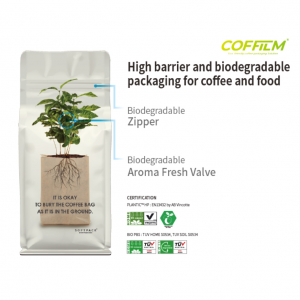A plant-based packaging material that can be recycled – or composted at home – makes design for circularity a realistic goal
It is well-known in recycling circles that packaging made from multiple layers of plastic can cause recovery issues at salvage stage. And, it is equally understood that perishable food demands performance from its wrapping that single source plastic solutions rarely provide.

Compostable coffee pouches made using Kuraray’s Plantic technology. The entire bag can be buried in the ground – valve, zipper and all are biodegradable.
What if there were a barrier material that kept food fresh, kept in aroma and kept oxygen out, but which could also be applied to a broad range of packaging solutions or formats? And, what if that material simply washed away or decomposed once its job was done? What if, when combined with other suitable compostable materials, the packaging or wrapper could be composted at home? Japanese headquartered Kuraray is making this happen globally with its renewable and sustainable starch-based barrier film Plantic.
‘This innovative material of ours plays a part in balancing the Earth’s carbon footprint,’ says Thomas Black, Kuraray’s director of international sales for Plantic. Using United States Department of Agriculture crop yield figures, Black calculates that the feedstock for the world’s entire annual barrier packaging needs can be produced in less than 100 square miles of farmland. Roughly, that equates to the land mass of Orlando in Florida, or Frankfurt in Germany.
‘The starch we use for Plantic can be grown year after year, and crop yields improve. Compare that to an oil feedstock, which you can take from the ground only once,’ adds Black.
Plantic is created using 25% less energy and emits 70% less greenhouse gas than its fossil fuel-derived alternatives, resulting in significantly lower carbon emissions. It does this without compromising on the barrier performance crucial to maintaining the quality of packaged food, so it is suitable as a packaging barrier material in a range of applications.
Read the full article at Chemistry World

